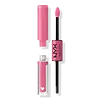NYX Cosmetics Shine Loud High Shine Lip Color & Gloss Versus Fenty Beauty Gloss Bomb Universal Lip Luminizer
What's inside
What's inside
 Key Ingredients
Key Ingredients

 Benefits
Benefits

 Concerns
Concerns

 Ingredients Side-by-side
Ingredients Side-by-side

Isododecane
EmollientTrimethylsiloxysilicate
EmollientNylon-611/Dimethicone Copolymer
Skin ConditioningDisteardimonium Hectorite
StabilisingLauroyl Lysine
Skin ConditioningMacadamia Ternifolia Seed Oil
EmollientCoriandrum Sativum Fruit Oil
MaskingSimmondsia Chinensis Seed Oil
EmollientPrunus Armeniaca Kernel Oil
MaskingPassiflora Edulis Seed Oil
EmollientC30-45 Alkyldimethylsilyl Polypropylsilsesquioxane
Sodium Hyaluronate
HumectantSilica
AbrasiveAlumina
AbrasiveAluminum Hydroxide
EmollientPropylene Carbonate
SolventParfum
MaskingBenzyl Alcohol
PerfumingCI 15850
Cosmetic ColorantCI 15985
Cosmetic ColorantCI 45380
Cosmetic ColorantCI 45410
Cosmetic ColorantCI 77491
Cosmetic ColorantCI 77492
Cosmetic ColorantCI 77499
Cosmetic ColorantCI 77891
Cosmetic ColorantMica
Cosmetic ColorantCI 19140
Cosmetic ColorantCI 42090
Cosmetic ColorantDimethicone
EmollientTocopheryl Acetate
AntioxidantIsododecane, Trimethylsiloxysilicate, Nylon-611/Dimethicone Copolymer, Disteardimonium Hectorite, Lauroyl Lysine, Macadamia Ternifolia Seed Oil, Coriandrum Sativum Fruit Oil, Simmondsia Chinensis Seed Oil, Prunus Armeniaca Kernel Oil, Passiflora Edulis Seed Oil, C30-45 Alkyldimethylsilyl Polypropylsilsesquioxane, Sodium Hyaluronate, Silica, Alumina, Aluminum Hydroxide, Propylene Carbonate, Parfum, Benzyl Alcohol, CI 15850, CI 15985, CI 45380, CI 45410, CI 77491, CI 77492, CI 77499, CI 77891, Mica, CI 19140, CI 42090, Dimethicone, Tocopheryl Acetate
Polybutene
Hydrogenated Polyisobutene
EmollientOctyldodecanol
EmollientSimmondsia Chinensis Seed Oil
EmollientEthylene/Propylene/Styrene Copolymer
Phenoxyethanol
PreservativeAroma
Parfum
MaskingTocopheryl Acetate
AntioxidantButylene/Ethylene/Styrene Copolymer
Tetrahexyldecyl Ascorbate
AntioxidantButyrospermum Parkii Butter
Skin ConditioningButyrospermum Parkii Butter Unsaponifiables
Skin ConditioningBHT
AntioxidantBenzyl Benzoate
AntimicrobialLimonene
PerfumingPolybutene, Hydrogenated Polyisobutene, Octyldodecanol, Simmondsia Chinensis Seed Oil, Ethylene/Propylene/Styrene Copolymer, Phenoxyethanol, Aroma, Parfum, Tocopheryl Acetate, Butylene/Ethylene/Styrene Copolymer, Tetrahexyldecyl Ascorbate, Butyrospermum Parkii Butter, Butyrospermum Parkii Butter Unsaponifiables, BHT, Benzyl Benzoate, Limonene
 Reviews
Reviews

Ingredients Explained
These ingredients are found in both products.
Ingredients higher up in an ingredient list are typically present in a larger amount.
Parfum is a catch-all term for an ingredient or more that is used to give a scent to products.
Also called "fragrance", this ingredient can be a blend of hundreds of chemicals or plant oils. This means every product with "fragrance" or "parfum" in the ingredients list is a different mixture.
For instance, Habanolide is a proprietary trade name for a specific aroma chemical. When used as a fragrance ingredient in cosmetics, most aroma chemicals fall under the broad labeling category of “FRAGRANCE” or “PARFUM” according to EU and US regulations.
The term 'parfum' or 'fragrance' is not regulated in many countries. In many cases, it is up to the brand to define this term.
For instance, many brands choose to label themselves as "fragrance-free" because they are not using synthetic fragrances. However, their products may still contain ingredients such as essential oils that are considered a fragrance by INCI standards.
One example is Calendula flower extract. Calendula is an essential oil that still imparts a scent or 'fragrance'.
Depending on the blend, the ingredients in the mixture can cause allergies and sensitivities on the skin. Some ingredients that are known EU allergens include linalool and citronellol.
Parfum can also be used to mask or cover an unpleasant scent.
The bottom line is: not all fragrances/parfum/ingredients are created equally. If you are worried about fragrances, we recommend taking a closer look at an ingredient. And of course, we always recommend speaking with a professional.
Learn more about ParfumThis oil comes from the seeds of the desert shrub called Jojoba. It is more commonly known as jojoba oil, a non-comedogenic oil.
Jojoba oil does not contain fragrance and has many fatty-acids, making it a great soothing ingredient.
It also contains Vitamin E, a great moisturizing ingredient. Vitamin E is also an antioxidant and protects your skin against oxidative damage.
This ingredient humectant properties, meaning it helps draw moisture from the air. This helps keep your skin hydrated.
While jojoba has antibacterial properties, it is only able to kill some strains of bacteria.
Studies also show it helps in wound healing. In fact, Indigenous cultures have used jojoba as a moisturizer and to help treat burns for centuries.
Fun fact: Jojoba oil similar to natural human skin sebum, so it has a great effect on dry skin. It is also promising with helping to regulate sebum production.
Due to its fatty acid content, Jojoba oil may not be fungal acne safe. We recommend speaking with a professional if you have any concerns.
Learn more about Simmondsia Chinensis Seed OilTocopheryl Acetate is AKA Vitamin E. It is an antioxidant and protects your skin from free radicals. Free radicals damage the skin by breaking down collagen.
One study found using Tocopheryl Acetate with Vitamin C decreased the number of sunburned cells.
Tocopheryl Acetate is commonly found in both skincare and dietary supplements.
Learn more about Tocopheryl Acetate